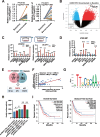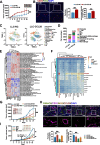Pericytes recruited by CCL28 promote vascular normalization after anti-angiogenesis therapy through RA/RXRA/ANGPT1 pathway in lung adenocarcinoma
- PMID: 39075504
- PMCID: PMC11285179
- DOI: 10.1186/s13046-024-03135-3
Pericytes recruited by CCL28 promote vascular normalization after anti-angiogenesis therapy through RA/RXRA/ANGPT1 pathway in lung adenocarcinoma
Abstract
Background: It has been proposed that anti-angiogenesis therapy could induce tumor "vascular normalization" and further enhance the efficacy of chemotherapy, radiotherapy, target therapy, and immunotherapy for nearly twenty years. However, the detailed molecular mechanism of this phenomenon is still obscure.
Method: Overexpression and knockout of CCL28 in human lung adenocarcinoma cell line A549 and murine lung adenocarcinoma cell line LLC, respectively, were utilized to establish mouse models. Single-cell sequencing was performed to analyze the proportion of different cell clusters and metabolic changes in the tumor microenvironment (TME). Immunofluorescence and multiplex immunohistochemistry were conducted in murine tumor tissues and clinical biopsy samples to assess the percentage of pericytes coverage. Primary pericytes were isolated from lung adenocarcinoma tumor tissues using magnetic-activated cell sorting (MACS). These pericytes were then treated with recombinant human CCL28 protein, followed by transwell migration assays and RNA sequencing analysis. Changes in the secretome and metabolome were examined, and verification of retinoic acid metabolism alterations in pericytes was conducted using quantitative real-time PCR, western blotting, and LC-MS technology. Chromatin immunoprecipitation followed by quantitative PCR (ChIP-qPCR) was employed to validate the transcriptional regulatory ability and affinity of RXRα to specific sites at the ANGPT1 promoter.
Results: Our study showed that after undergoing anti-angiogenesis treatment, the tumor exhibited a state of ischemia and hypoxia, leading to an upregulation in the expression of CCL28 in hypoxic lung adenocarcinoma cells by the hypoxia-sensitive transcription factor CEBPB. Increased CCL28 could promote tumor vascular normalization through recruiting and metabolic reprogramming pericytes in the tumor microenvironment. Mechanistically, CCL28 modified the retinoic acid (RA) metabolism and increased ANGPT1 expression via RXRα in pericytes, thereby enhancing the stability of endothelial cells.
Conclusion: We reported the details of the molecular mechanisms of "vascular normalization" after anti-angiogenesis therapy for the first time. Our work might provide a prospective molecular marker for guiding the clinical arrangement of combination therapy between anti-angiogenesis treatment and other therapies.
Keywords: Anti-angiogenesis therapy; CCL28; Lung adenocarcinoma; Pericytes; Retinoic acid; Vascular normalization.
© 2024. The Author(s).
Conflict of interest statement
The authors declare that they have no competing interests.
Figures







Similar articles
-
Hypoxia Induces Overexpression of CCL28 to Recruit Treg Cells to Enhance Angiogenesis in Lung Adenocarcinoma.J Environ Pathol Toxicol Oncol. 2021;40(1):65-74. doi: 10.1615/JEnvironPatholToxicolOncol.2020035859. J Environ Pathol Toxicol Oncol. 2021. PMID: 33639074
-
Hypoxia induced CCL28 promotes angiogenesis in lung adenocarcinoma by targeting CCR3 on endothelial cells.Sci Rep. 2016 Jun 2;6:27152. doi: 10.1038/srep27152. Sci Rep. 2016. PMID: 27250766 Free PMC article.
-
IFN-γ-mediated suppression of ANGPT2-Tie2 in endothelial cells facilitates tumor vascular normalization during immunotherapy.Front Immunol. 2025 Apr 30;16:1551322. doi: 10.3389/fimmu.2025.1551322. eCollection 2025. Front Immunol. 2025. PMID: 40370455 Free PMC article.
-
Angiogenesis as a hallmark of solid tumors - clinical perspectives.Cell Oncol (Dordr). 2021 Aug;44(4):715-737. doi: 10.1007/s13402-021-00602-3. Epub 2021 Apr 9. Cell Oncol (Dordr). 2021. PMID: 33835425 Review.
-
Pericytes: a double-edged sword in cancer therapy.Future Oncol. 2015;11(1):169-79. doi: 10.2217/fon.14.123. Future Oncol. 2015. PMID: 25143028 Review.
Cited by
-
Microvascularization of the Vocal Folds: Molecular Architecture, Functional Insights, and Personalized Research Perspectives.J Pers Med. 2025 Jul 7;15(7):293. doi: 10.3390/jpm15070293. J Pers Med. 2025. PMID: 40710410 Free PMC article. Review.
-
Pericytes in hematogenous metastasis: mechanistic insights and therapeutic approaches.Cell Oncol (Dordr). 2025 Aug;48(4):921-941. doi: 10.1007/s13402-025-01073-6. Epub 2025 May 20. Cell Oncol (Dordr). 2025. PMID: 40392500 Free PMC article. Review.
References
MeSH terms
Substances
LinkOut - more resources
Full Text Sources
Medical
Molecular Biology Databases
Miscellaneous

